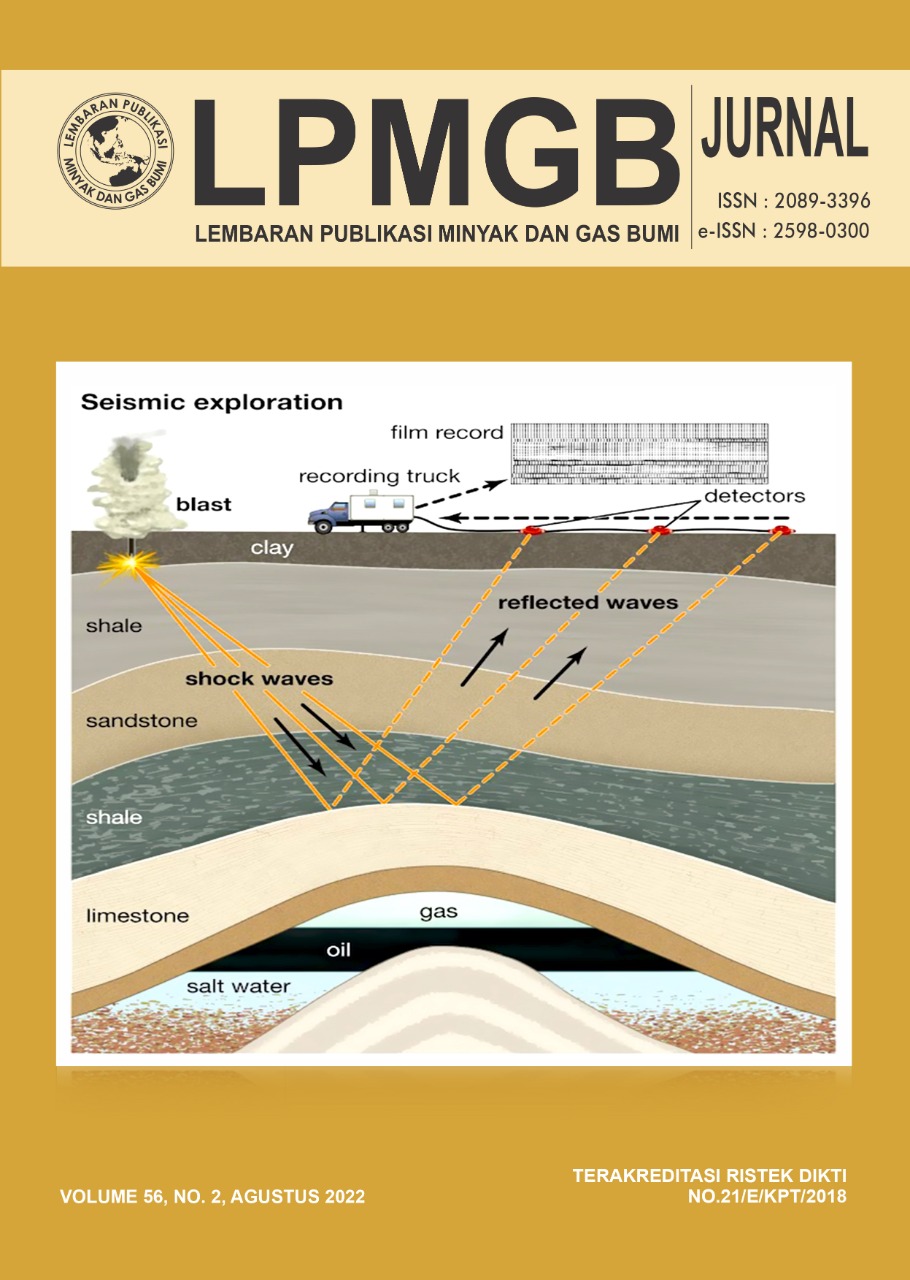PENGEMBANGAN METODA EKSPLORASI GEOKIMIA MERKURI ARSENIK DAN H2S DI DAERAH PROSPEK GEOTHERMAL DAN UJI VALIDASINYA
DOI:
https://doi.org/10.29017/LPMGB.56.2.1175Kata Kunci:
Membran, Adsorben, Survei Geokimia, Merkuri, Arsenik, H2S, Lapangan Ulubelu, Geothermal, Passive Soil SamplingAbstrak
Penyelidikan penggunaan paket adsorben terbuat dari membran Polytetrafluoro ethylene (PTFE) dan karbon aktif yang telah dimpregnasi larutan Kalium Iodida (KI) dan Kalium Hidroksida (KOH) untuk menangkap merkuri, arsenik dan H2S di area yang terdapat prospek geothermal. Tujuan dari penyelidikan ini adalah mengembangkan metoda adsorben penangkap merkuri (Hg) yang selama ini menggunakan adsorben emas dengan adsorben berbahan baku karbon aktif dalam bentuk paket adsorben yang dapat menangkap 3 senyawa sekaligus yaitu Hg, As dan H2S secara efektif dan efisien. Survei Hg, As, dan H2S dilakukan dengan metoda passive soil gas sampling dengan cara penanaman paket adsorben sebanyak 300 paket selama kurun waktu 2 minggu di lapangan geothermal Ulubelu Lampung dimana terdapat sumber panas bumi sekaligus sebagai lokasi untuk uji validasinya. Hasil analisa Hg, As, dan H2S terhadap paket adsorben setelah masa penanaman menunjukkan korelasi yang positif yang mengindikasikan keberadaan struktur (patahan) di bawah permukaan dan adanya zona-zona temperatur yang bervariasi dan telah sesuai (80%) dengan peta struktur yang telah valid. Pengembangan metoda survei ini diharapkan dapat mengurangi biaya survei eksplorasi geotheÂ
Referensi
Akito Koga , Sachihiro Taguchi , and William
A. J. Mahon (1982); The Use of
Volatile Constituents in Geothermal Fluids
For Assessing The Type, Potensial and
Near Surface Permeability Of Geothermal
System; Proceedings of New Zealand Geothermal
Workshop 1982
Engle, M. A., Sexauer, M., & Zhang, H.
(2008). Quantifying natural source mercury
emissions from the Ivanhoe Mining District
, north-central Nevada , USA, 35(2001),
–3997.
EPA Method 375.4: Sulfate by Turbidity.
(1978).
Gerald K.Van Kooten Geothermal exploration
Using Surface Mercury Geochemistry;
Journal of Volcanology and Geothermal Research
Vol 31, April 1987
Giroud, N., Abbruzzini, T. F., Silva, C. A.,
Andrade, D. A. de, Carneiro, W. J. de
O., ASTM, … Sandstrom, M. W. (2014).
Speciation of volatile arsenik at geothermal
features in Yellowstone National Park. City,
(December), 57. https://doi.org/10.1016/j.
gca.2006.02.019
Gmbh, C. (2009). Activated Carbon from Carbon
Link : Impregnated activated carbon for
environmental protection Activated Carbon
from Carbon Link : Impregnated activated
carbon for environmental protection Page 2
of 14, 1–14.
J.C.Varekamp P. R. Buseck. H. g Anomalies
in soils: A geochemical exploration method
for geothermal areas; Geothermic; Vol 12,
Method and apparatus for the collection
of reduced gases. (1990). Retrieved from
http://www.google.ca/patents/CA2020744C
Millipore.com (2018, 1 September). Microfiltration
Membranes for Laboratory. Diakses
pada 2 September 2018, https://Millipore.
com/ Product Selection Guide
Noda, T., 1981, Volatile mercury capture with
a gold needle and its application to geothermal
prospecting; Proceedings of New Zealand
Geothermal Workshop 1981, - 230
Peña-Icart, M., Villanueva Tagle, M. E.,
Alonso-Hernández, C., RodrÃguez
Hernández, J., Behar, M., & Pomares Alfonso,
M. S. (2011). Comparative studi of
digestion methods EPA 3050B (HNO 3-H
O 2-HCl) and ISO 11466.3 (aqua regia)
for Cu, Ni and Pb contamination assessment
in marine sediments. Marine Environmental
Research, 72(1–2), 60–66. https://doi.
org/10.1016/j.marenvres.2011.05.005
Planer-friedrich, B., & Merkel, B. J. (2006).
Volatile Metals and Metalloids in Hydrothermal
Gases, 40(10), 3181–3187.
PT.Pertamina Geothermal Energy (PGE)
( 2018)
PT. Pertamina Research and Technology
Center (RTC), 2018, Laporan Rancang Bangun
Adsorben
Science, S. (2014). Effect of KI and KOH Impregnations
over Activated Carbon on H2S
Adsorption Performance at Low and High ..
Effect of KI and KOH Impregnations over
Activated, (July). https://doi.org/10.1080/01
2013.841240
Services, B. E., & Air, B. (n.d.). Passive,
non-intrusive soil-gas sampling method to
target elemental mercury.
Tang, J. (2013). Ambient and Soil-Gas Assessment
of Geothermal Hydrogen Sulfide (H
S) and Methane (CH 4) in Clearlake, CA
Jenny Tang, (Ch 4), 1–26.
Tassi, F., Cabassi, J., Calabrese, S., Nisi, B.,
Venturi, S., & Capecchiacci, F. (2016). Applied
Geochemistry Diffuse soil gas emissions
of gaseous elemental mercury (GEM)
from hydrothermal-volcanic systems : An
innovative approach by using the static
closed-chamber method. Applied Geochemistry,
, 234–241.
Toxicol, J. E. A., Shewchuk, S. R., Azargohar,
R., & Dalai, A. K. (2016). Environmental
& Analytical Toxicology Elemental Mercury
Capture Using Activated Carbon : A
Review, 6(4). https://doi.org/10.4172/2161-
1000379
Work, S. V. (2002). AOAC Guidelines for
Single Laboratory Validation of Chemical
Methods for Dietary Supplements and Botanicals,
–38.

